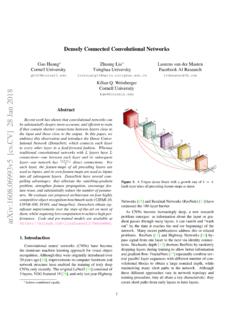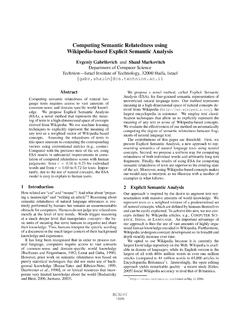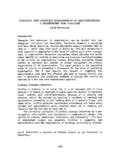Transcription of arXiv:1301.3781v3 [cs.CL] 7 Sep 2013
1 Efficient Estimation of Word Representations inVector SpaceTomas MikolovGoogle Inc., Mountain View, ChenGoogle Inc., Mountain View, CorradoGoogle Inc., Mountain View, DeanGoogle Inc., Mountain View, propose two novel model architectures for computing continuous vector repre-sentations of words from very large data sets. The quality of these representationsis measured in a word similarity task, and the results are compared to the previ-ously best performing techniques based on different types of neural networks. Weobserve large improvements in accuracy at much lower computational cost, ittakes less than a day to learn high quality word vectors from a billion wordsdata set.
2 Furthermore, we show that these vectors provide state-of-the-art perfor-mance on our test set for measuring syntactic and semantic word IntroductionMany current NLP systems and techniques treat words as atomic units - there is no notion of similar-ity between words, as these are represented as indices in a vocabulary. This choice has several goodreasons - simplicity, robustness and the observation that simple models trained on huge amounts ofdata outperform complex systems trained on less data. An example is the popular N-gram modelused for statistical language modeling - today, it is possible to train N-grams on virtually all availabledata (trillions of words [3]).
3 However, the simple techniques are at their limits in many tasks. For example, the amount ofrelevant in-domain data for automatic speech recognition is limited - the performance is usuallydominated by the size of high quality transcribed speech data (often just millions of words). Inmachine translation, the existing corpora for many languages contain only a few billions of wordsor less. Thus, there are situations where simple scaling up of the basic techniques will not result inany significant progress, and we have to focus on more advanced progress of machine learning techniques in recent years, it has become possible to train morecomplex models on much larger data set, and they typically outperform the simple models.
4 Probablythe most successful concept is to use distributed representations of words [10]. For example, neuralnetwork based language models significantly outperform N-gram models [1, 27, 17]. Goals of the PaperThe main goal of this paper is to introduce techniques that can be used for learning high-quality wordvectors from huge data sets with billions of words, and with millions of words in the vocabulary. Asfar as we know, none of the previously proposed architectures has been successfully trained on more1 [ ] 7 Sep 2013than a few hundred of millions of words, with a modest dimensionality of the word vectors between50 - use recently proposed techniques for measuring the quality of the resulting vector representa-tions, with the expectation that not only will similar words tend to be close to each other, but thatwords can havemultiple degrees of similarity[20].
5 This has been observed earlier in the contextof inflectional languages - for example, nouns can have multiple word endings, and if we search forsimilar words in a subspace of the original vector space, it is possible to find words that have similarendings [13, 14].Somewhat surprisingly, it was found that similarity of word representations goes beyond simplesyntactic regularities. Using a word offset technique where simple algebraic operations are per-formed on the word vectors, it was shown for example thatvector( King ) - vector( Man ) + vec-tor( Woman )results in a vector that is closest to the vector representation of the wordQueen[20].
6 In this paper, we try to maximize accuracy of these vector operations by developing new modelarchitectures that preserve the linear regularities among words. We design a new comprehensive testset for measuring both syntactic and semantic regularities1, and show that many such regularitiescan be learned with high accuracy. Moreover, we discuss how training time and accuracy dependson the dimensionality of the word vectors and on the amount of the training Previous WorkRepresentation of words as continuous vectors has a long history [10, 26, 8]. A very popular modelarchitecture for estimating neural network language model (NNLM) was proposed in [1], where afeedforward neural network with a linear projection layer and a non-linear hidden layer was used tolearn jointly the word vector representation and a statistical language model.
7 This work has beenfollowed by many interesting architecture of NNLM was presented in [13, 14], where the word vectors arefirst learned using neural network with a single hidden layer. The word vectors are then used to trainthe NNLM. Thus, the word vectors are learned even without constructing the full NNLM. In thiswork, we directly extend this architecture, and focus just on the first step where the word vectors arelearned using a simple was later shown that the word vectors can be used to significantly improve and simplify manyNLP applications [4, 5, 29].
8 Estimation of the word vectors itself was performed using differentmodel architectures and trained on various corpora [4, 29, 23, 19, 9], and some of the resulting wordvectors were made available for future research and comparison2. However, as far as we know, thesearchitectures were significantly more computationally expensive for training than the one proposedin [13], with the exception of certain version of log-bilinear model where diagonal weight matricesare used [23].2 Model ArchitecturesMany different types of models were proposed for estimating continuous representations of words,including the well-known Latent Semantic Analysis (LSA) and Latent Dirichlet Allocation (LDA).
9 In this paper, we focus on distributed representations of words learned by neural networks, as it waspreviously shown that they perform significantly better than LSA for preserving linear regularitiesamong words [20, 31]; LDA moreover becomes computationally very expensive on large data to [18], to compare different model architectures we define first the computational complex-ity of a model as the number of parameters that need to be accessed to fully train the model. Next,we will try to maximize the accuracy, while minimizing the computational test set is available imikolov/ imikolov/rnnlm/ ehhuang/2 For all the following models, the training complexity is proportional toO=E T Q,(1)whereEis number of the training epochs,Tis the number of the words in the training set andQisdefined further for each model architecture.
10 Common choice isE= 3 50andTup to one models are trained using stochastic gradient descent and backpropagation [26]. Feedforward Neural Net Language Model (NNLM)The probabilistic feedforward neural network language model has been proposed in [1]. It consistsof input, projection, hidden and output layers. At the input layer,Nprevious words are encodedusing 1-of-Vcoding, whereVis size of the vocabulary. The input layer is then projected to aprojection layerPthat has dimensionalityN D, using a shared projection matrix. As onlyNinputs are active at any given time, composition of the projection layer is a relatively cheap NNLM architecture becomes complex for computation between the projection and the hiddenlayer, as values in the projection layer are dense.
![arXiv:0706.3639v1 [cs.AI] 25 Jun 2007](/cache/preview/4/1/3/9/3/1/4/b/thumb-4139314b93ef86b7b4c2d05ebcc88e46.jpg)

![@google.com arXiv:1609.03499v2 [cs.SD] 19 Sep 2016](/cache/preview/c/3/4/9/4/6/9/b/thumb-c349469b499107d21e221f2ac908f8b2.jpg)













